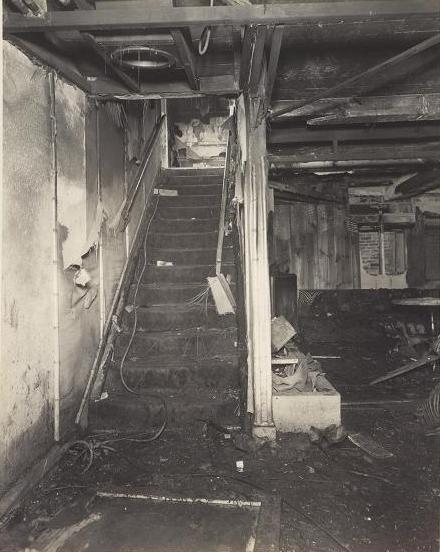This is about the deadliest nightclub fire in U.S. history but less dramatically could apply to many other areas of life.
The Cocoanut Grove fire
From the U.S. National Archives:
Saturday, November 28, 1942, at the U.S. Navy Yard in Boston, Massachusetts, had been, for the most part, a relatively uneventful day.
According to the duty log, 19 ships were berthed at the yard or at nearby auxiliary piers along Boston Harbor. Duty officers performing periodic patrols took note of the vessels that navigated in and out of the yard and the South Boston Naval Annex throughout the calm yet cold, freezing day. Indeed, such activity was common for this strategic shipbuilding facility, which produced and repaired numerous vessels for use during World War II.
However, before Saturday had elapsed, the sailors and Marines of the yard would heed a call for aid that was anything but routine.
Boston newspapers greeted their readers with the day’s updates of the war in Europe and the Pacific, which, nearly a year after the attack on Pearl Harbor, had become and would continue to be regular practice throughout the war. In late 1942, Bostonians were reading of the Allies’ months-long struggle against the Imperial Japanese forces at Guadalcanal and the Soviet Red Army’s counteroffensive against the German Sixth Army at Stalingrad.
Local college football fans diverted their attention to Fenway Park for the annual late-season Jesuit-school rivalry game, in which the Holy Cross Crusaders achieved a stunning 55-12 upset victory, over the top-ranked Boston College Eagles, denying BC an undefeated season and an invitation to the Sugar Bowl.
Despite the outcome of the game, it was Thanksgiving weekend, and many servicemen throughout the First Naval District were looking forward to enjoying leave away from their duties. For many officers and enlisted men with free time, it was an opportunity for an evening of dinner, drinks, and dancing with their dates. And there were few more desirable places to do just that in Boston than at the famous Cocoanut Grove night club.
At 10:15 p.m., a Small Fire Begins to Spread Quickly
For nearly a decade following the end of Prohibition, “The Grove,” located in the Bay Village neighborhood of Boston, was one of the most popular social scenes in the city. Sporting a South Seas–style ambiance, the club treated patrons to food, hospitality, and entertainment, as well as the occasional appearance of music artists or movie stars gracing the dinner-goers with their presence.
On this Saturday night, more than 1,000 patrons packed the main dining room and cocktail lounges at the Cocoanut Grove. Despite the cancellation of a Boston College victory celebration after the football team’s defeat that afternoon, the club had no difficulty in filling the establishment, especially with a floor show about to begin.
Then suddenly, at approximately 10:15 p.m., a small fire broke out in the club’s basement Melody Lounge. Eyewitnesses recounted that they had first spotted the fire in a decorative palm tree in the lounge, working its way up to the ceiling. According to U.S. Naval Reserve Ens. William G. Burns, who had been present in the Melody Lounge around that time, the fire began slowly and appeared to be of such a nature that club employees could extinguish it. Suddenly, to everyone’s alarm, the fire raced across the ceiling, causing the crowd to scatter for safety.
Within eight minutes of the first sight of flames, the fire, fueled by ample wall and ceiling decorations, had engulfed the entire club, spreading upstairs into the street-level foyer and main dining room. As shouts of “Fire!” rang out while heavy smoke and flames emerged from downstairs, the club lights went out and panic ensued. U.S. Naval Reserve Lt. John Kip Edwards, Jr., who had been upstairs in another of the Grove’s lounges and escaped the fire, noted that “it seemed that when the lights went out everybody’s intellect went with them.”
Black Smoke, Darkness, and Jammed Doors
Unable to see and increasingly unable to breathe due to the billowing, black smoke, patrons stumbled over dining room furniture, frantically searching for a way out of the danger. Amidst the chaos and confusion, many were trampled and crushed, especially at the club’s main exit, a revolving door that jammed after being overwhelmed by the rush of patrons seeking to escape.
A second outlet, consisting of an inward-opening door, effectively became a wall as the panicked crowd pushed forth in an attempt to flee to the streets. Additional exits, if they could be located in the dark, were either blocked or obscured, leaving hundreds trapped within the inferno, desperately hoping for outside rescuers to break through the barriers.....MUCH MORE
From Boston Fire History:
The Story of the Cocoanut Grove Fire

View from the Melody Lounge up the 4-foot wide staircase, the only public means of egress.
....MUCH MORE
For an overview of the science of getting out of danger see January's ""The Fuzzy Logic of Fleeing for Your Life"" which has this story as part of the outro:
....One of the more interesting examples of people actually doing the right thing was the crash of Air France Flight 358 in Toronto. Attempting to land in really lousy weather the plane went too far down the runway and into a ravine. There were 309 people on board......
....The flight attendants got everybody, all 309, off the plane in 125 seconds.
[The passenger load comprised 297 passengers: 168 adult males; 118 adult females; 8 children; and 3 infants. Adult passengers included: three wheelchair passengers and one blind passenger.]
Think about that the next time you board and look around at your fellow passengers.
Could they do it?

The picture above is a screengrab of a video taken two minutes later.
[there are discrepancies in the time it took to evacuate, ranging from 90 seconds to the figure above, 125 seconds]